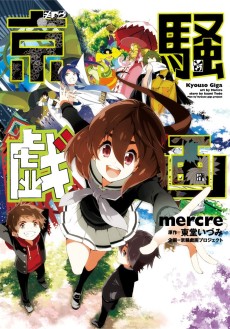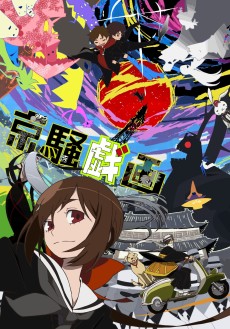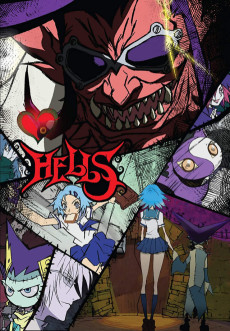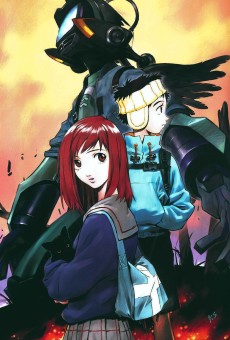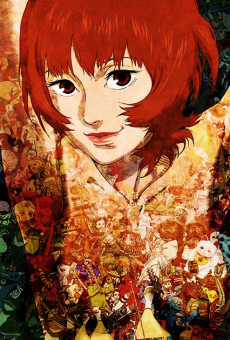KYOUSOUGIGA (TV)
STATUS
COMPLETE
EPISODES
10
RELEASE
December 19, 2013
LENGTH
26 min
DESCRIPTION
In Kyoto, nothing changes. No, not that Kyoto, but rather the Mirror Capital Kyoto, the world inside of a painting! Colorful, beautiful, but static, the people of this world live an idyllic, if boring life. That is, until Koto appears, like a wrecking ball slamming into still waters.
Koto's never met her mother, and in search of clues about her missing parent, she winds up in the very place she's supposed to be, yet least expected. What unfolds is a tale of a crazy, mixed-up family, where the father has mysterious powers, the mother is a goddess, and the siblings have an intense rivalry that will finally see its conclusion... even if that conclusion brings about the attention of the Shrine, an organization dedicated to protecting the multiverse.
(Source: Discotek)
CAST
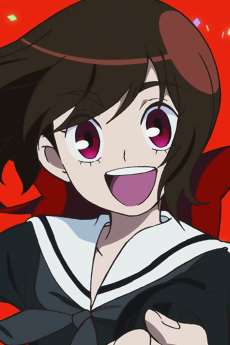
Koto
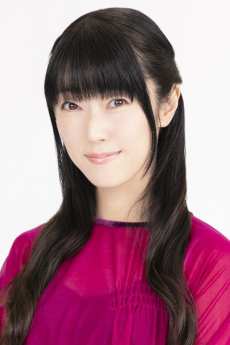
Rie Kugimiya
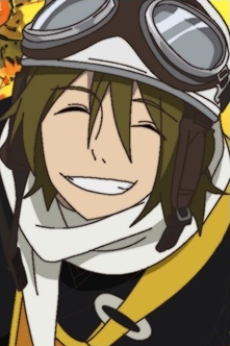
Myoue
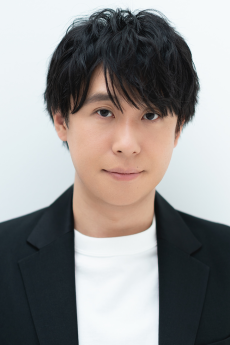
Kenichi Suzumura
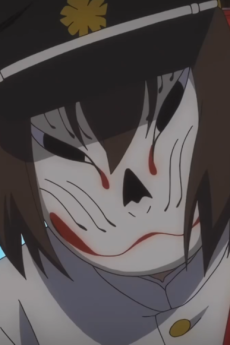
Inari
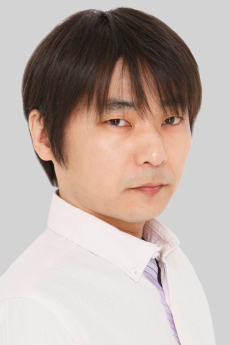
Akira Ishida
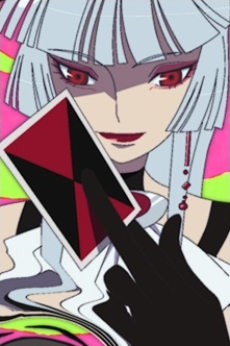
Lady Koto
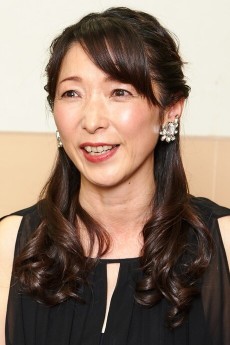
Aya Hisakawa
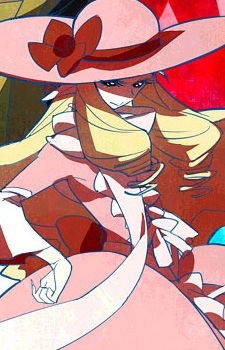
Douji Yase
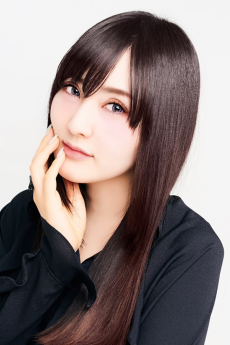
Eri Kitamura
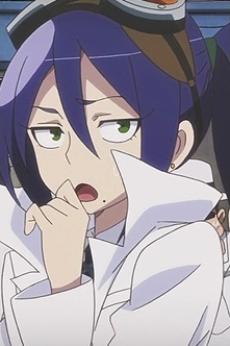
Shouko
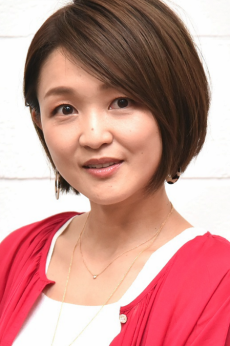
Chiwa Saitou
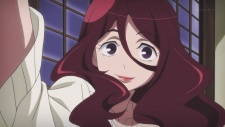
Danji
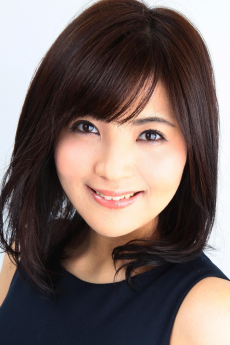
Yukiko Morishita
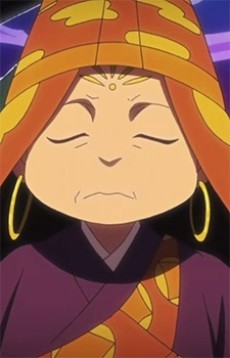
Kurama
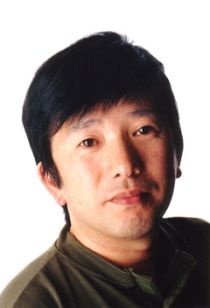
Shigeru Nakahara
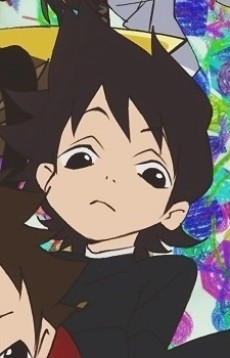
Un
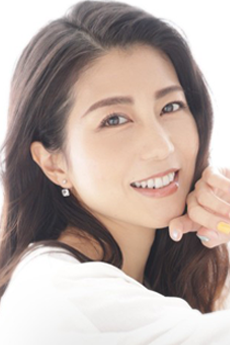
Ryouko Shiraishi
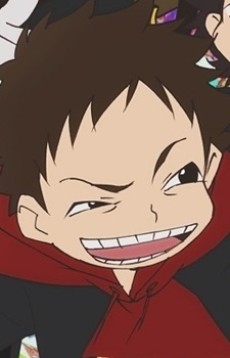
A
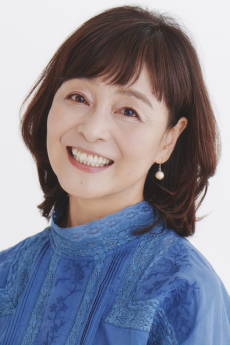
Noriko Hidaka
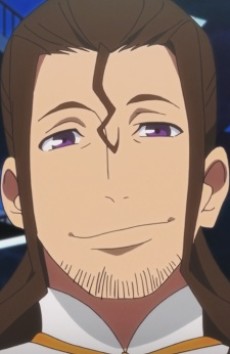
Guuji
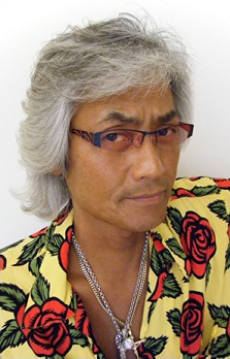
Kazuki Yao
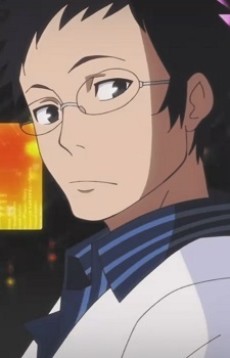
Fushimi
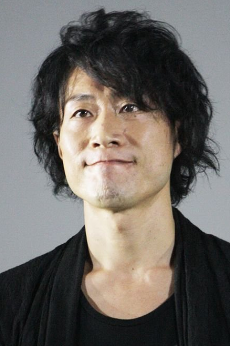
Eiji Takemoto
EPISODES
Dubbed
RELATED TO KYOUSOUGIGA (TV)
REVIEWS

YuiHirasawa39
54/100Delivers on fanatical but comes short on character development, focus balance, and pacingContinue on AniListOBVIOUS SPOILERS BELOW
I’ve been trying to vary things up with my reviews recently – moving away from the general discussion of music, character plot in a formulaic fashion. Thankfully, all these elements of Kyousou Giga has been discussed to death in these reviews, so I’m going to diverge and talk a bit about what I do and don’t like in this show – any of those more detailed elements are otherwise easily found. I should also clarify that this is largely a criticism. Kyousou Giga is quite positively reviewed, and the majority of the popular reviews here fail to identify some of its major weaknesses – something I hope to address here.
First of all, looking at the narration, I’ve got to recognize the nonconventional (and nonlinear) style. It’s no mystery that I’m a fan of nonchronological works - for a series that explicitly identifies itself as one about destruction and rebirth I find it appropriate. The point of this narration style is that you actually don’t get most of the story in a massive exposition dump, at least unless you’re extremely perceptive or unusually attuned to the nuances. However, I do struggle quite a bit with the way in which Toei uses it. Nonchronological shows rely largely on character development to drive their audience’s interest, relying on the viewers to build the story and work out the details. Did I say nonchronological? Interestingly, most of this story is chronological, but the method of explaining the details absolutely isn’t. Instead, a lot of this character development, and thus the audience’s keys to working it out, is anti-chronological, meaning what we get more and more toward the end.
Now is this a bad thing? Not necessarily – as long as there’s enough to build the story. But what constantly frustrated me throughout my watch-though is that the details we do get don’t have the effect we’re looking for. Remember what I said earlier about character development driving the story? We get plenty of character development, but so little of it helps to push the story forward, all up until the final two or three episodes. Other reviewers have exhaustively discussed the details, so I’ll just use one example here. Inari claims that he wants to die (or disappear, if that’s your intended interpretation) no earlier than halfway through the final episode. Wouldn’t a detail so critical to his character development be valuable earlier on? Wouldn’t that help to draw the rebirth and destruction parallels much more strongly between Myoue and himself? We get plenty about his character throughout the show, but critical details that actually drive the story seem to be largely missing.
Now don’t get me wrong, there’s elements of this suspension of details that I do really love in this show. A great example of this might be the purpose of Kurama and Yase’s creation, something that isn’t fully clarified until the second-last episode. But this one is far more cleverly done. Enough hints are given – right from the opening few episodes – of their purpose, hints that are clearly portrayed through character development in the right spots. But my issue lies, again, in importance. Sure, this might be an interesting development, but it really doesn’t help to drive the story forward. As a viewer, I feel as if I’m sent on a variety of interesting but ultimately insignificant side-quests. Some of the really important details are just too obfuscated for me to follow. Again, drawing from a simple example, I didn’t even realize that Myoue and Inari are the same entity until episode 7, which in a 10-episode series, is kind of a shame. Couldn’t we have gotten some more explicit details on a topic that’s so fundamental to the conclusion of this show any earlier?
Moving on, then, onto my other criticisms of this show, I’ve got to do some commentary on where Toei places their focus. We get a lot of character development on Koto, who is a wonderfully strong character in her own right, but relatively little on her older brother, who I’d argue is the more nuanced of the two. What do I mean by this? It’s temping to see his resolution to continue living (again, last episode) as enough, but I think it’s unsatisfying. Do we ever see him coming to terms with being reborn against his own will into a family that he doesn’t belong to? Are we satisfied with his gift and re-gift of the creation beads, which suggest a grasp that he personally holds on his own life? Or are we content with him living because Koto asked him to? Again, I’m sure there’s way more to his character than this, and perhaps I’m just too dense to see it, but I can’t help but wish that we got more of this developed, in its own anti-chronological order, throughout the show.
In a related topic, I’m also a bit frustrated with the use of some of the show’s characters. There’s obviously the main cast, all of whom directly influence the plot and development of the story, but there’s also a surprising amount of others whom I feel are thrown in just to be forgotten later. Inari’s brother, who seems to appear only for the antagonistic moments? Fushimi and Shouko? Even Danji, whose proximity to Myoue you’d think would offer her some more character development throughout the show? It seems that we get relatively little about all these lesser members of the cast, which really diminished the depth of the fantastical world that they live in.
Finally, I’m going to talk about the art style and its relationship with the story. The story is fanatical – whimsical, mythical, whatever you want to call it. The art is as well. The style foregoes all realism for bright colors, large shapes, and clear motifs. And for the most part, the artstyle fits the story; however, I can’t help but feel that in some places, it doesn’t agree with me. I’ve said this about other shows, but there’s no one place I’d like to pause Kyousou Giga and screengrab it for my desktop background. I can’t quite put my finger on what about it bothers me – possibly that something is literally born out of monk’s idle sketches seems a bit excessive. It seems that most people love the artstyle and I’m in the minority here, but I’m throwing out this opinion in case anyone finds familiarity with it.
I have little else to say and am gratified to have for once limited myself in review length. I wouldn’t rewatch this show for myself, nor can I give it more than a mediocre recommendation for whatever spoiler-nuts may be reading this right now. If you like more than a dash of confusion and some ridiculous fantasy, go for it – if you’re looking for serious plot development through pointed characterization, you may want to look elsewhere.

user5421954
92/100Kyousougiga is a Hidden Gem That More Should KnowContinue on AniListIt always sounds so pretentious to say that a work is only made more perfect by its imperfections. At best it seems like a meaningless, sophomoric word game; at worst it seems like you're trying to make whatever you're talking about immune from criticism. But I can't say why I love Kyousougiga so much without doing that, so there you go.
I'll at least be specific: when I say "imperfections" I'm talking about the obscurity of how the story is laid out; the slight visual inconsistency (the final scenes of episode 4, for example, are animated by a different person than episode 7's climax, and Koto's design is quite noticeably different in each); the first 5 episodes' insularity and consequent lack of sense that the narrative is progressing; and the way all the pertinent facts are finally revealed in one massive, unwieldy monologue that suddenly telescopes the scale and is also almost too much to take in all at once.
The reason I appreciate all these things so much is mainly because of the show's setting. The Mirror Capital is full of anachronisms and looks like it's made of paper cutouts. We know from the outset that it's a drawing come to life, and it looks like it. This comes across as self-reflexive to an extent, but really what I get out of it is just that the Mirror Capital was deliberately constructed by someone. It's a world made by parents for their children.
That's plainly obvious in episode 3, when Inari takes Kurama around the capital and tries to give him the means to pursue his interests. It's not an original or uncommon idea that parents will try to build a world for their children both to protect them and to foster their interests. Nor is it surprising that eventually, children want to leave that world.
It probably wouldn't surprise anyone to observe that Kyousougiga is about kids trying to escape a world constructed by their father's egoism and fear. (I happen to really dig that kind of thing.) But Koto (the little one) really makes the difference for me. Her conception was itself an act of rebellion on Inari's part, but she ends up being the one to resolve the consequences of his rebellion. She doesn't go totally over to the other side, of course; she doesn't submit to the Shrine's high priest.
Even though Inari's rebellious bent is behind the show's entire conflict, it's the reason why Koto, Yakushimaru, Kurama, and Yase exist. And he does love them, even if his love is imperfect. When they try to escape from the Mirror Capital, they're not rising to some kind of greater reality; the Mirror Capital is as real as the other 12 spheres, in the end. They're reacting to Inari's imperfections, and they'll bring that with them wherever they go. Even if kids leave their parents' world, their perspectives can still be influenced by the contrast between their parents' world and the countless other worlds out there.
Inari gave all his kids specific purposes, and they don't betray those purposes. But they do own them and direct them all toward their own ends. It's what lets Kurama be a great governor and inventor, what lets Yase provide a home for all the bizarre monsters that live in the Mirror Capital, and what lets Koto fight back against the Shrine. It's also something Yakushimaru struggles to do, but he gets help from his siblings (and NOT from Inari).
The constant interplay of imperfections lets everyone in Kyousougiga constantly develop and embrace their lives. Even if Koto's design is more angular and exaggerated in episode 4 than episode 7, it serves the scene well; even though the first episodes are insular and without momentum, the way they contrast with the latter episodes speaks to how the characters' lives change after the Mirror Capital is opened; and even if Inari's big reveal at the end is awkward and mind-boggling, it's easy to see it for what it is: a "dropping of the scales," when kids first have to really see their parents as fallible.
That's why one of my favorite scenes in the show is when a young Koto, crying in the middle of the night, finds out her dad can also cry. Her strength, and the way her strength ultimately comes to be what Inari really needs, comes not just from how he nurtured and taught her; it comes from how they were able to share something in their imperfections.

RiPHopscotch
95/100Breaking the Rules is FunContinue on AniListKyousougiga has one of the best finales of anything that I’ve seen. I do know that’s a weird way to start a review – by praising the conclusion – but in my defense this is a pretty weird show. The narrative structure is unconventional to the extreme, and normally when writers (who typically are looking to show off how smart they are) go for something like this, the result is an incoherent train wreck. This is one of the rare cases when, despite at times being hard to follow, eschewing storytelling norms works. Even though Kyousougiga is just ten episodes long, it manages to establish a cast of charming characters, tell a touching story about a girl’s quest to find a black rabbit, and then bring it home with a heartwarming message about finding meaning through family; in short, breaking the “rules” of storytelling lets this show do more with less.
It’s… difficult to talk about the plot of Kyousougiga, in no small part because the narrative is structured in a way that is deliberately hard to follow. Koto is a 14-year-old girl with superpowers and a magic hammer, working alongside her father and mentor Inari for a group of interdimensional peacekeepers called “The Shrine”. One day she sets out to find a spirit who has taken the form of a black rabbit and eventually winds up in the Looking Glass City, a kind of alternate version of Kyoto that was created by a priest named Myoue and his wife, who also happens to be named Koto. Since they vanished, the city has been run by the “Council of Three”, which is comprised of the couple’s children Kurama, Yase and Myoue (yes, there are two pairs of significant characters that share names). Over the course of her journey, Koto will come to learn more about these three, their troubled lives and the world they rule over, while simultaneously having elements of her own life and upbringing recontextualized.

So where does the weird narrative structure come in? The show is comprised of two seemingly different stories that converge, and the viewer is almost constantly left in the dark, frantically trying to reconcile new information from one plot thread with what was previously learned in the other. The first five episodes are also really just focused on establishing characters, so they tend to jump around from past to present and place to place. Since there isn’t a logical progression of events nothing is immediately clear, however, as an overwhelming amount of information is hinted at or implied, no twist is absolutely shocking; the audience is basically left needing to infer what will happen next based on several pieces of unconfirmed guesswork. With the fast pace of Kyousougiga this is so much fun, and really rewards viewers for paying attention. I never felt like I was fully up to speed until the end of the show when everything clicked, but at the same time I felt like I knew what was happening, even if there was no way I’d be able to explain it.
Just like how the rules around telling a story can be broken, the rules around making a good character are not exactly set in stone. Typically the protagonist will be the one driving the plot forward, and as their journey progresses they’ll grow and change. I often will look to well-done character development as a sign of quality writing, and it generally contributes a ton to fantastic stories. There are times, however, when what’s needed from a character is the exact opposite of growth.
When (kid) Koto is introduced, it’s clear from the start what kind of person she is. Although Inari wasn’t an awful parent he certainly took a rather hands-off approach to raising his daughter, so she grew up as a kid with superpowers and very little adult supervision. As a result, Koto is high energy and hard-headed, impulsive with a mischievous streak a mile wide; she’s driven solely by her emotions. With that being said, she’s also a fundamentally good person, who always tries to do her version of the “right” thing. This blend of qualities not only makes her a fun character to watch, but also a very effective one, as ultimately she is the one driving other characters to change.

*Koto's pursuit of the "best ending"* What I really love about Koto, however, is that she isn’t just some “wunderkind” who can do no wrong. People are frequently trying to use her to further their goals, and, like the audience, she’s constantly kept in the dark, with nobody explaining anything to her. As the show progresses we see how frustrating this is, the expectations she places on herself, and the mistakes she makes as a result. Koto may have superpowers but she’s still a 14-year-old, and the same emotions that have been driving her forward throughout her entire life eventually lead her into a massive downward spiral. Normally to pull out of this a character would have a set piece moment showcasing how much they’ve grown, but Kyousougiga doesn’t do that. In the end, it’s the people Koto has changed over her journey that save her from self-destructing, and the conclusion goes on to drive home how Koto hasn’t changed at all – I personally can’t imagine a more fitting way to wrap everything up.

*Serving as a stand-in for every audience member with no clue what's going on* Since the show is fond of breaking the rules around telling a story and constructing characters, it seems fitting that one of the themes at the heart of Kyousougiga is, essentially, that breaking the rules is okay. Whether these rules are small – like something as basic as “please don’t smash the house with your magical hammer” – or more universal in scale, people are going to break them. What’s refreshing about Kyousougiga’s approach to this message, however, is that it doesn’t just handwave it away as “the ends justify the means” or lean too far the other way and focus just on how, even if the wrong thing is done for the right reasons, devastating punishment is warranted. The message here is much more human and relatable: breaking the rules is okay because familial love is unconditional. Individuals might have to bear the weight of the actions, sure, but family won’t abandon them. Is it the most “realistic” take? Of course not. But watching it in action will put a smile on the face of viewers, and maybe even bring a tear to their eye. It’s hard to ask for more than that.

On a more technical note, I think that the visuals of the show will stand out immediately for a lot of people. Kyousougiga has a vibrant color palette with a variety of bright colors and it isn’t afraid to use them, helping the Looking Glass City feel like it’s really from some kind of alternate reality. The clean lines and solid colors of characters contrast very effectively against the almost watercolor-esque art of the background, allowing the characters to be identifiable whenever they’re on screen without making them standout in a jarring manner. The show is light on the action, so the direction helps to keep the viewer engaged, varying from moment to moment as it transitions from one shot to another, often in a way that coincides with the dialogue. When there are bursts of action it’s done well, with movement being sudden and fast paced, and impacts that feel like they have real weight behind them. The art does a lot, and I feel like it's a major contributing factor as to why the show works so well.
*Step aside Usain Bolt* Here’s the thing: I know, in spite of everything I've just said, that Kyousougiga is imperfect. I may have loved the visual style but it certainly isn’t for everyone, and at times the writing does kind of revel in how convoluted it’s being. But when I put minor nitpicks and criticisms I have aside, what I’m left with is a show that takes a lot of risks and does the vast majority of what it needs to do right. More importantly than that, though, it’s fun. I was hooked basically from the start, I had a blast watching Koto wreak havoc and power through everything that stood in her way, and when everything was said and done I watched the end of the show with a smile on my face. To paraphrase a much beloved copypasta from the general E-sports community, other series may be breaking box office or streaming records, but Kyousougiga is breaking the rules – I wouldn’t want it any other way.
SIMILAR ANIMES YOU MAY LIKE
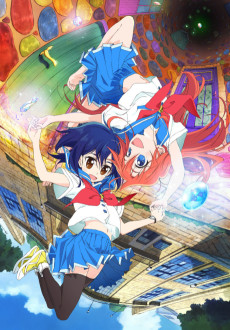 ANIME ActionFlip Flappers
ANIME ActionFlip Flappers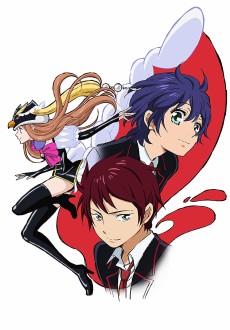 ANIME DramaMawaru Penguindrum
ANIME DramaMawaru Penguindrum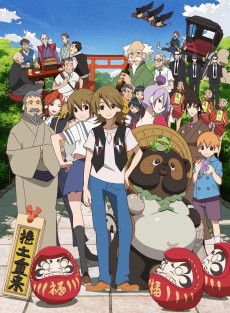 ANIME ComedyUchouten Kazoku
ANIME ComedyUchouten Kazoku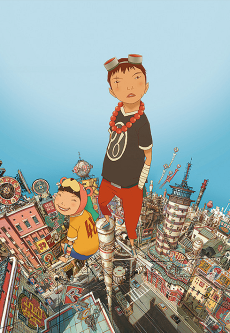 MOVIE ActionTekkon Kinkreet
MOVIE ActionTekkon Kinkreet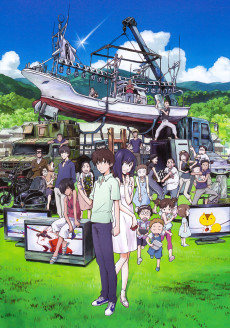 MOVIE ActionSummer Wars
MOVIE ActionSummer Wars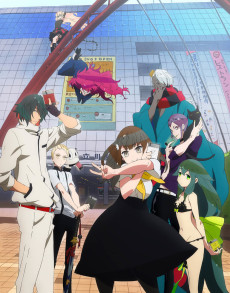 ANIME ActionGatchaman Crowds
ANIME ActionGatchaman Crowds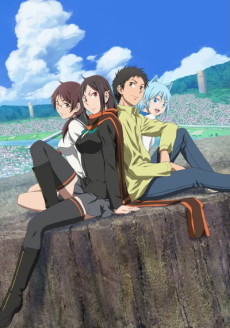 ANIME ActionYozakura Quartet
ANIME ActionYozakura Quartet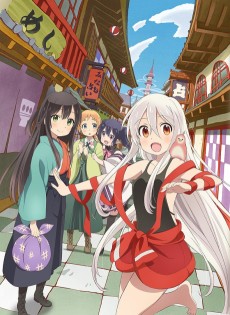 ANIME ComedyUrara Meirochou
ANIME ComedyUrara Meirochou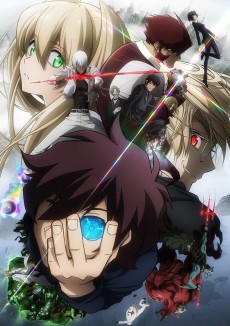 ANIME ActionKekkai Sensen
ANIME ActionKekkai Sensen
SCORE
- (3.75/5)
MORE INFO
Ended inDecember 19, 2013
Main Studio Toei Animation
Trending Level 2
Favorited by 1,242 Users



